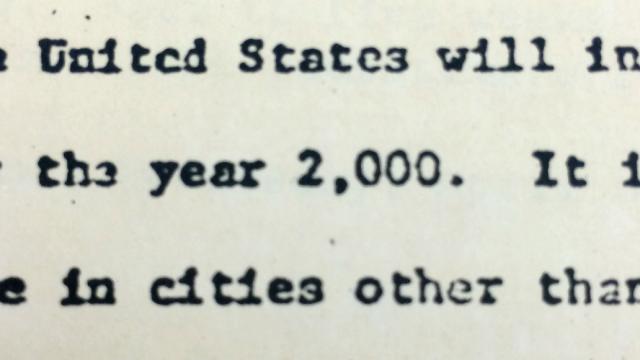Otto A. Silha, was a pretty forward-thinking guy — especially in an industry that we think of today as tremendously resistant to change. Silha was the publisher of the Minneapolis Star and Tribune newspapers, and he was known for embracing new technologies in the publishing business. He was enthusiastic about computers, networking, and the tools that he thought would make his business most efficient: robot editors.
Silha gave a speech in Paris on November 14, 1968 at an international conference for newspaper publishers about a computer technology that we’re only now seeing come into practical use: the automatic copy editor. I’m currently in Minnesota doing research on experimental cities, but just came across a copy of this speech in the University of Minnesota archives. I thought I’d share part of the speech, since it’s such an incredibly accurate portrayal of the actual future we’re seeing unfold in the 21st century.
I’ve transcribed an excerpt from his speech below.
Basically, the Research Center has developed a program so that the computer reads a story, places a numerical value upon each word in the story and through mathematical formulas determine what is most important in the story and then regenerates the story into the length that it was instructed to do. This technique uses the computer to shorten a story, literally without human intervention.
We recognise that most editors will not care for computer editing. We feel, however, that the ANPAT program has many practical applications in the future. As soon as computer display devices become practical, a newspaper editor will be able to modify the computer-shortened story to add the individual editor’s touch.
We think the abstracting techniques will offer the wire services great advantage in the future in that they will be able to furnish to newspaper, swiftly and automatically, abstracts of the stories on the wire budget of that day. This will greatly ease the load of the wire editors. Some newspaper editor may be satisfied with just the 100 word abstract of the story. If he wants 500 words, he can ask the wire service for the longer version, or even 1,000 if that is the full length available. You can imagine the saving in transmission and story editing time which this could make happen.
We also feel that the ANPAT program will provide an ideal method of filing stories in the electronic morgue of the future by providing “automated” abstracts and therefore making best use of the expensive electronic storage. The ANPAT program is the first known system developed for true computer editing performed without human intervention, other than to tell the unit the length of the story desire. We think that the ANPAT program will find many applications in the future as we move toward all-electronic composition.
Interestingly, the Associated Press has recently urged all reporters to tighten up their stories, limiting them to 300-500 words or 500-700 for stories deemed incredibly important or need more depth. They’re also relying on bots to make this happen.
I did a quick search for the ANPAT program but haven’t found much. I’ll definitely be following up on the vision for this computer-based editing when I’m not waist-deep in experimental cities. But if you know more about this futuristic-sounding (and admittedly still controversial) auto-editing technique, please share your knowledge with us in the comments.
